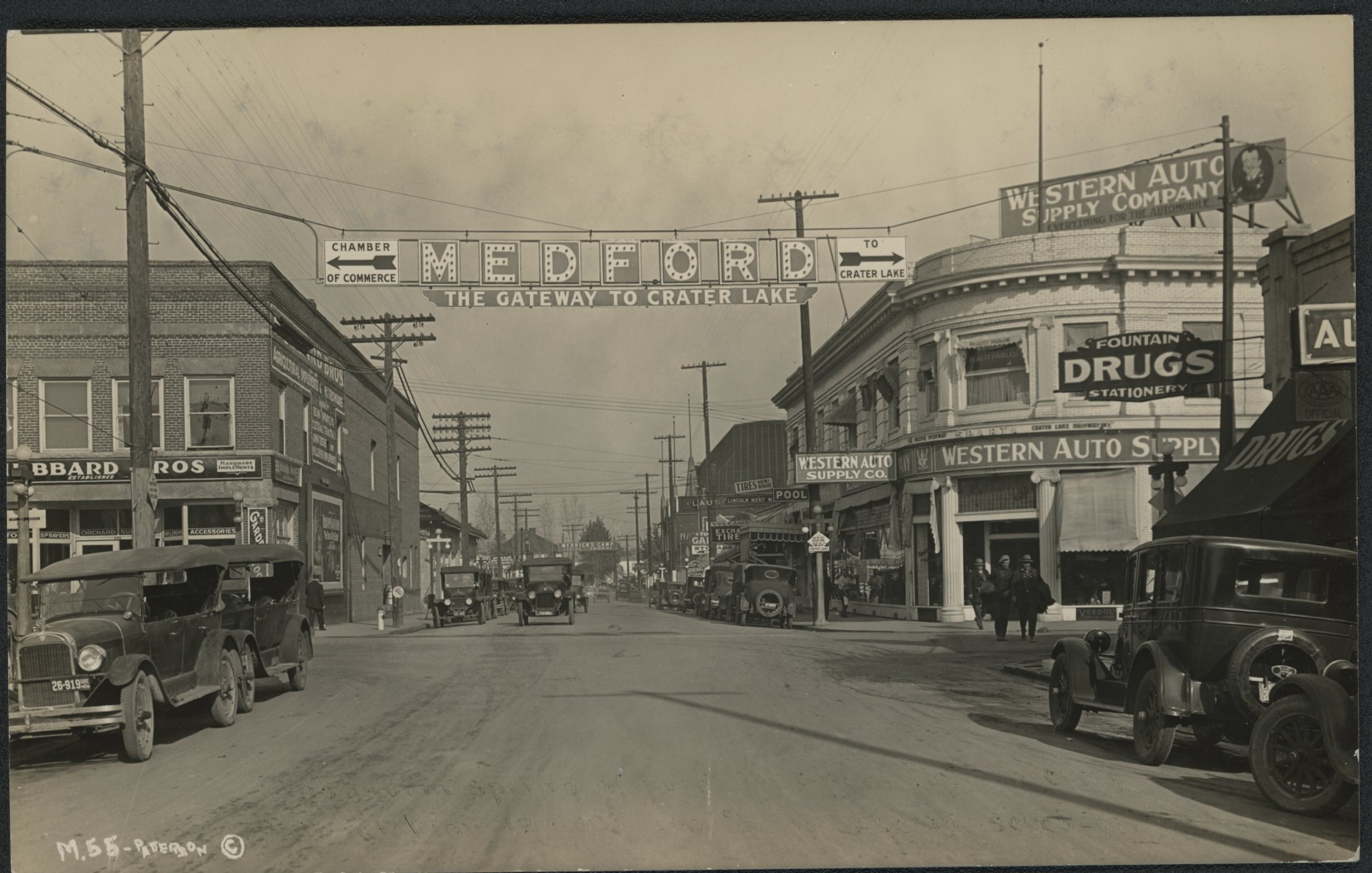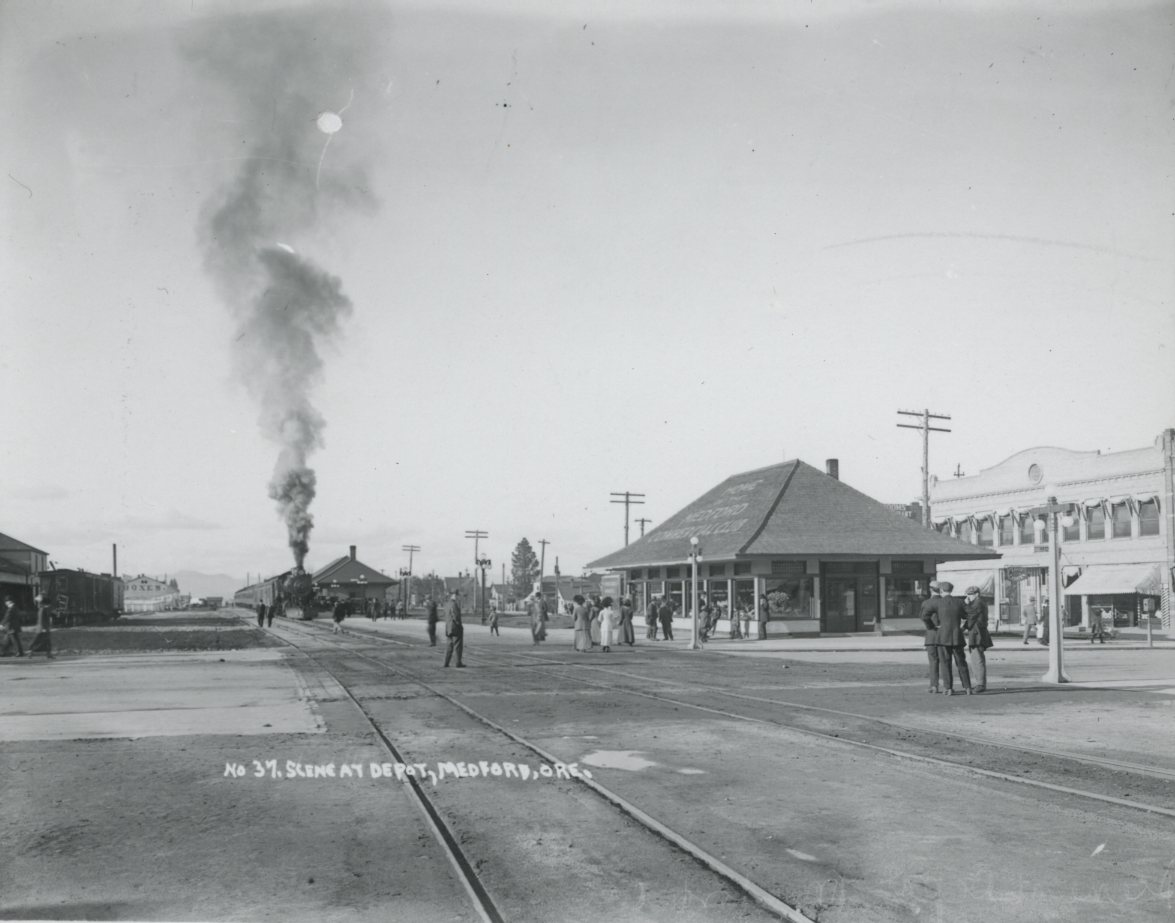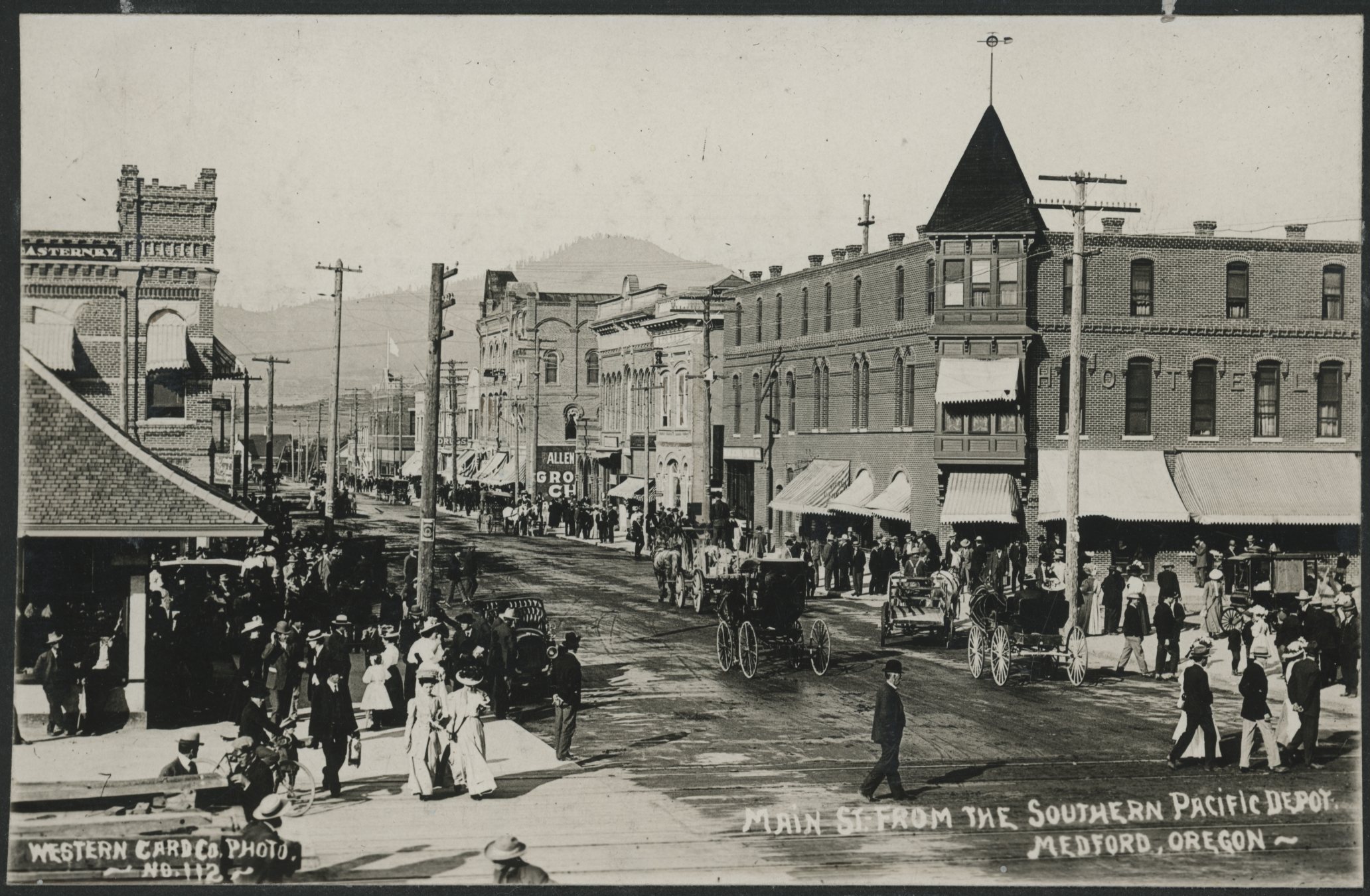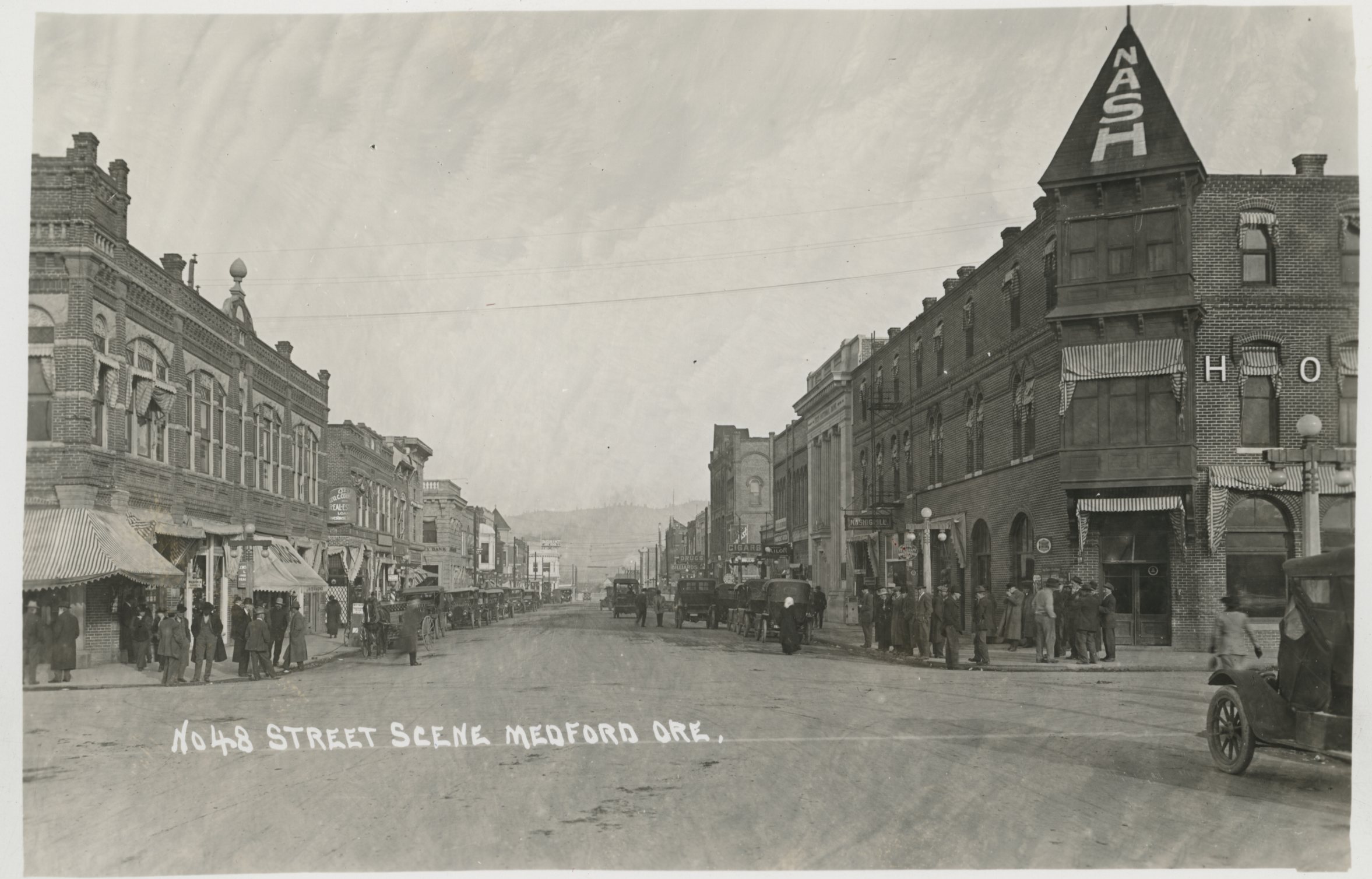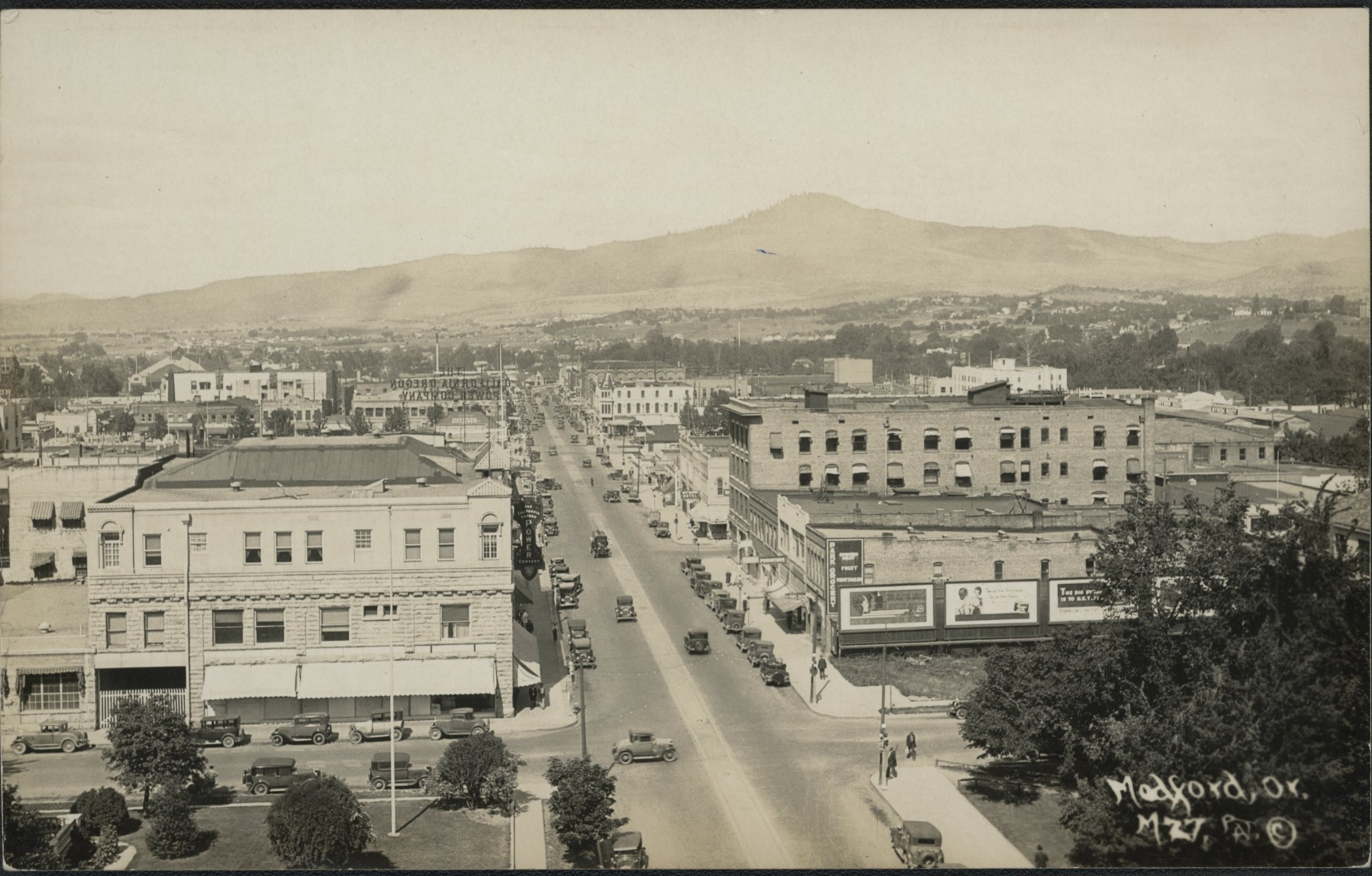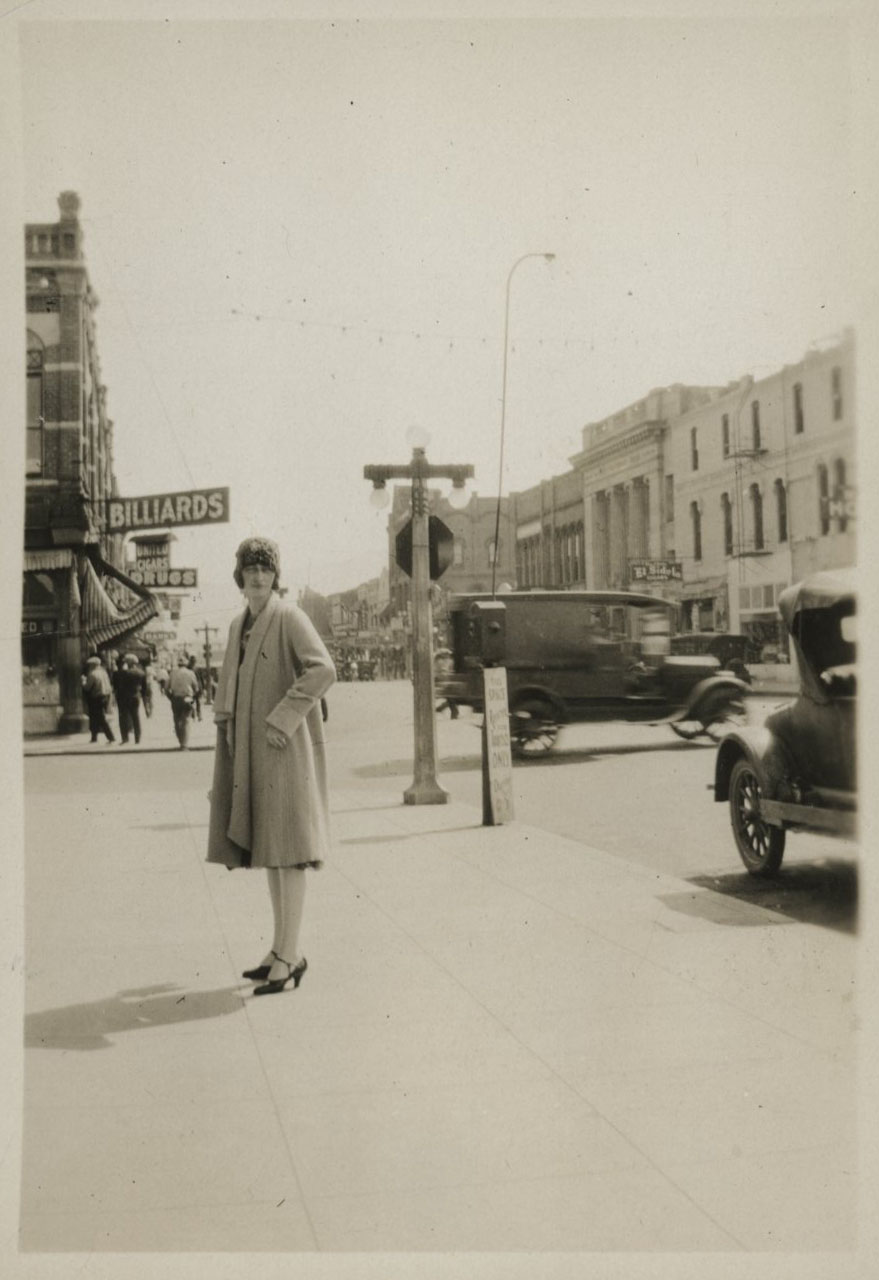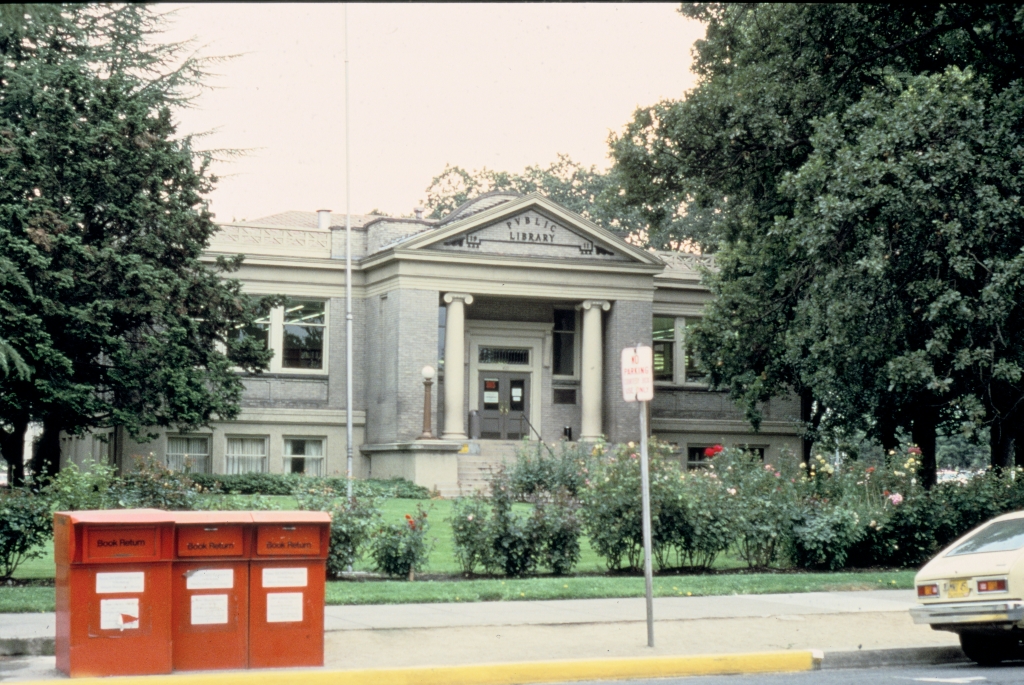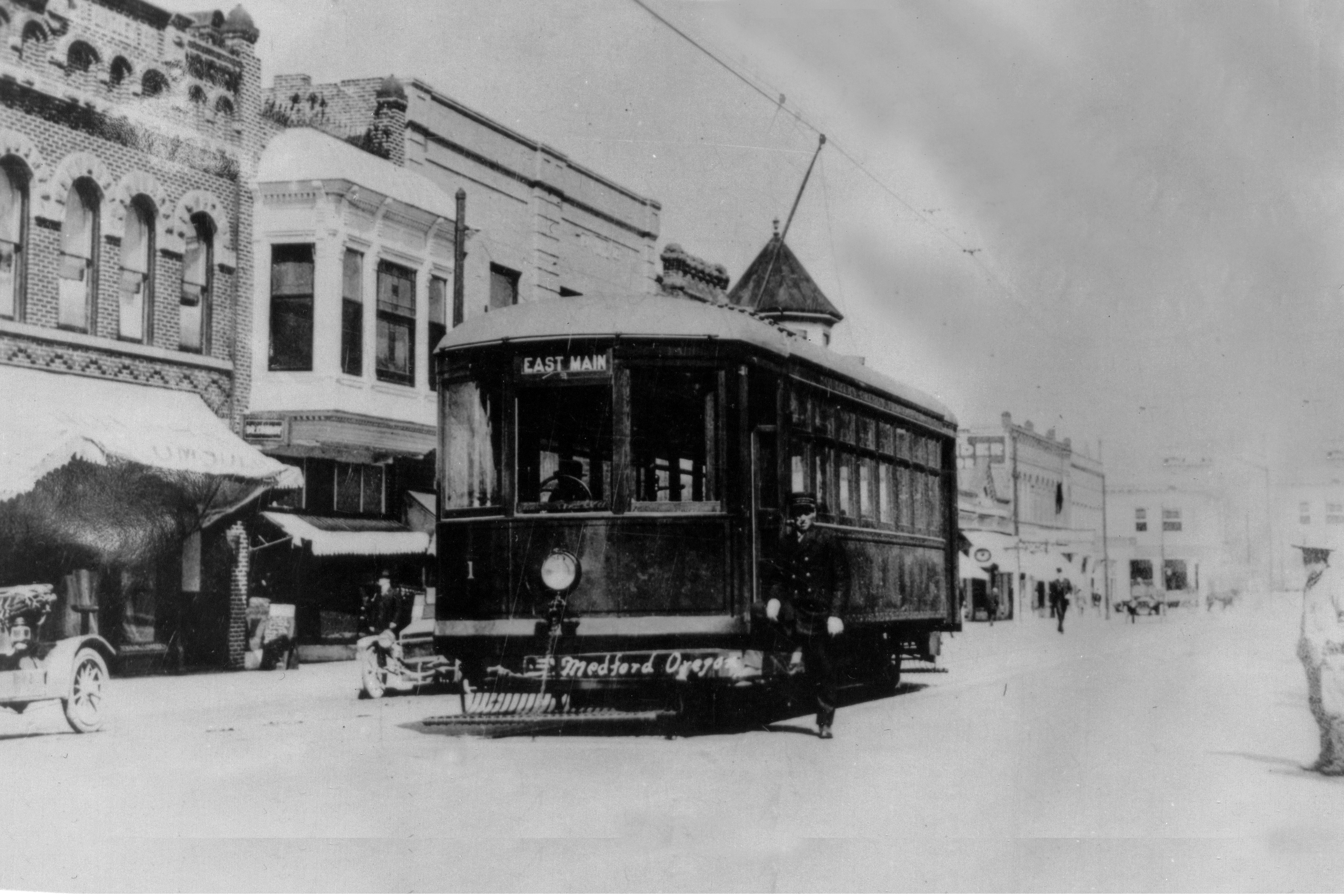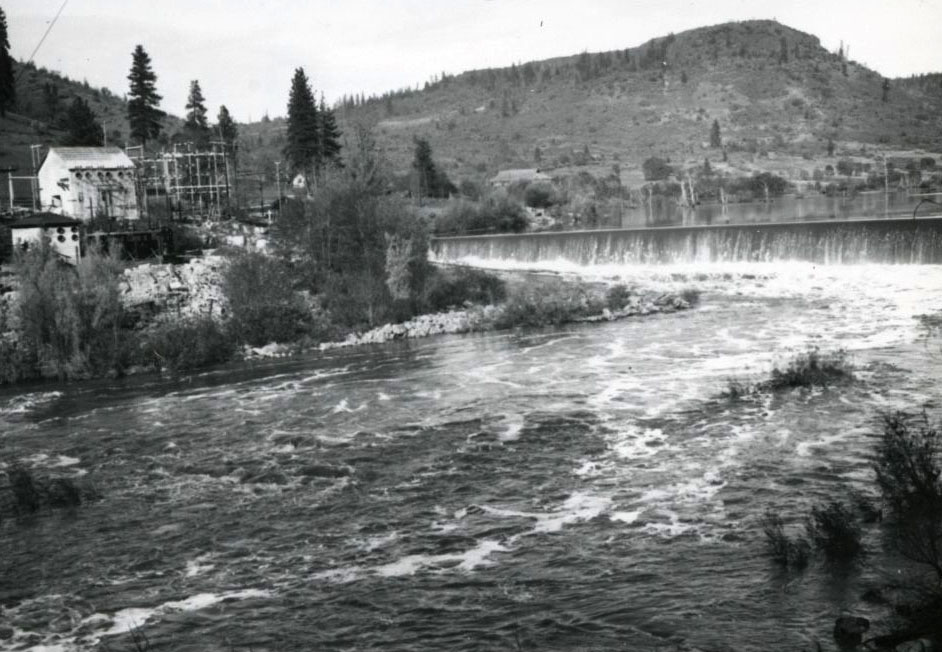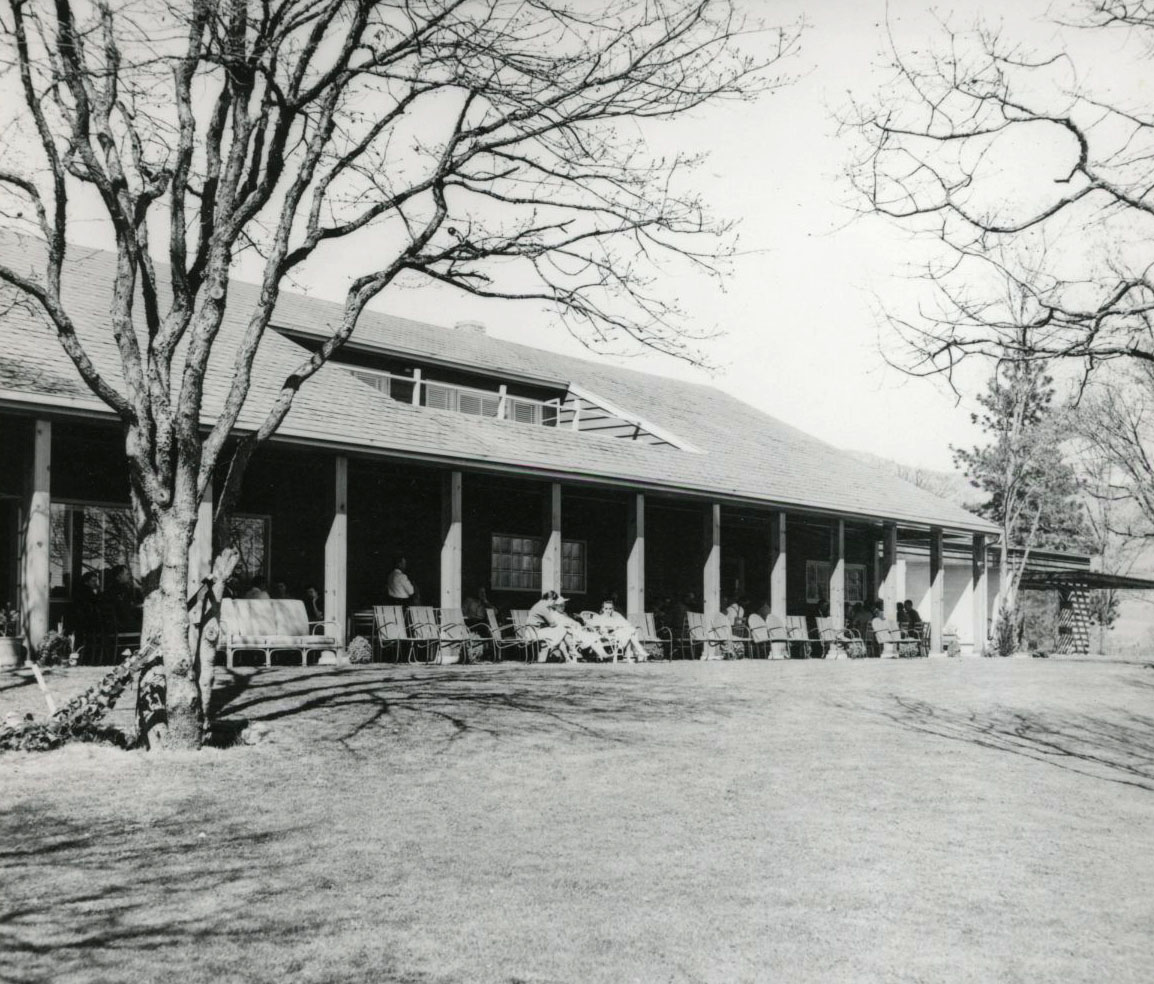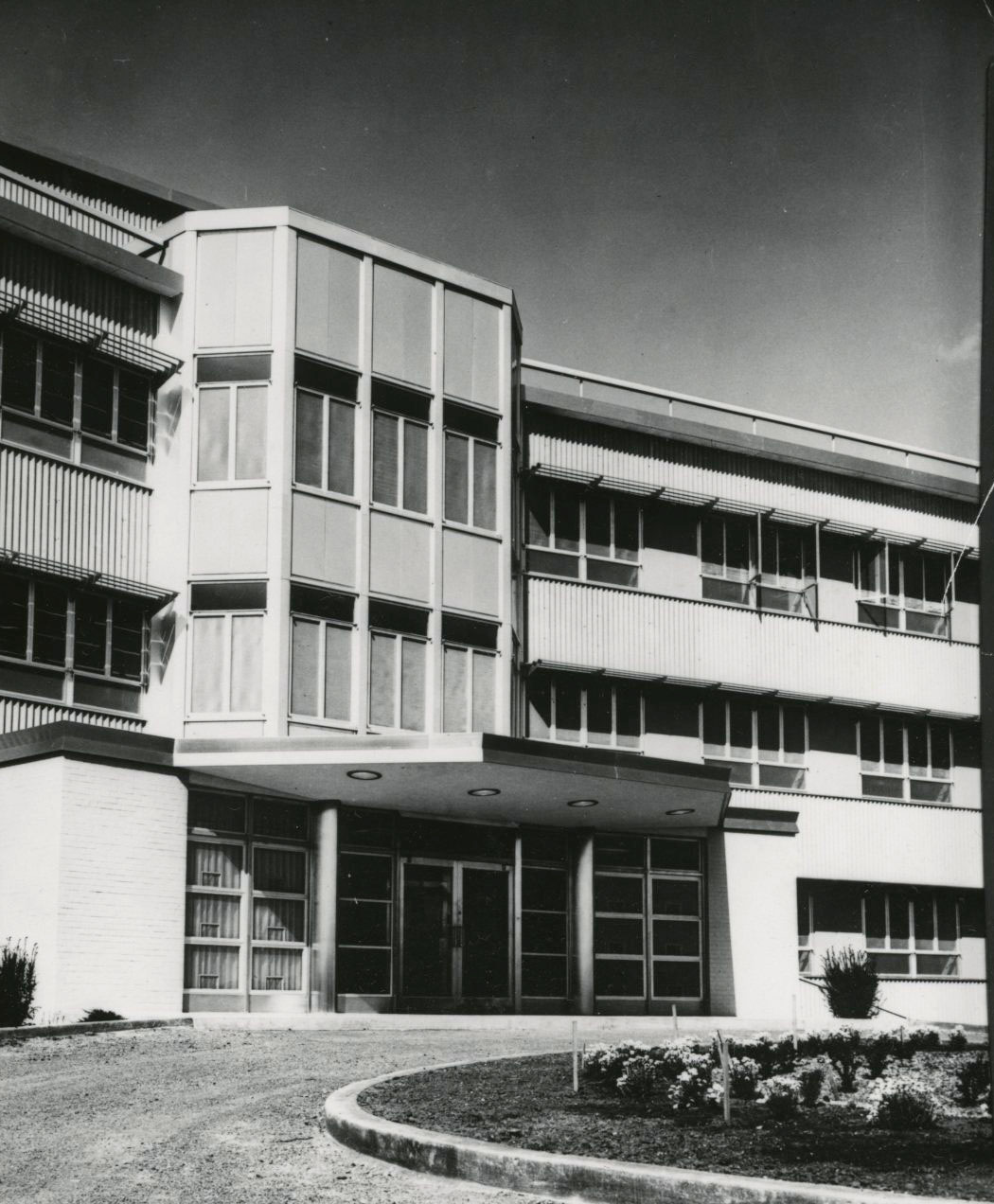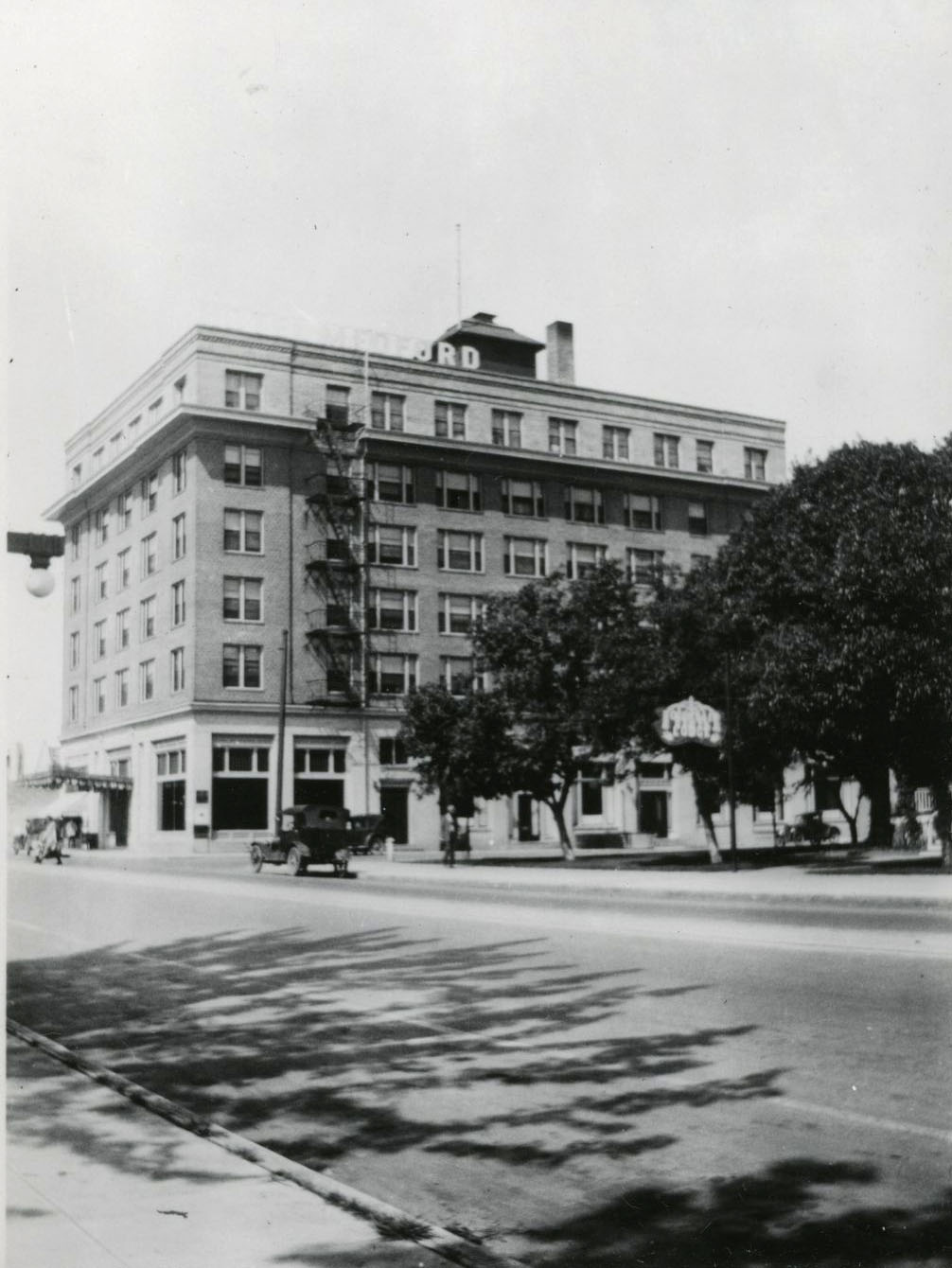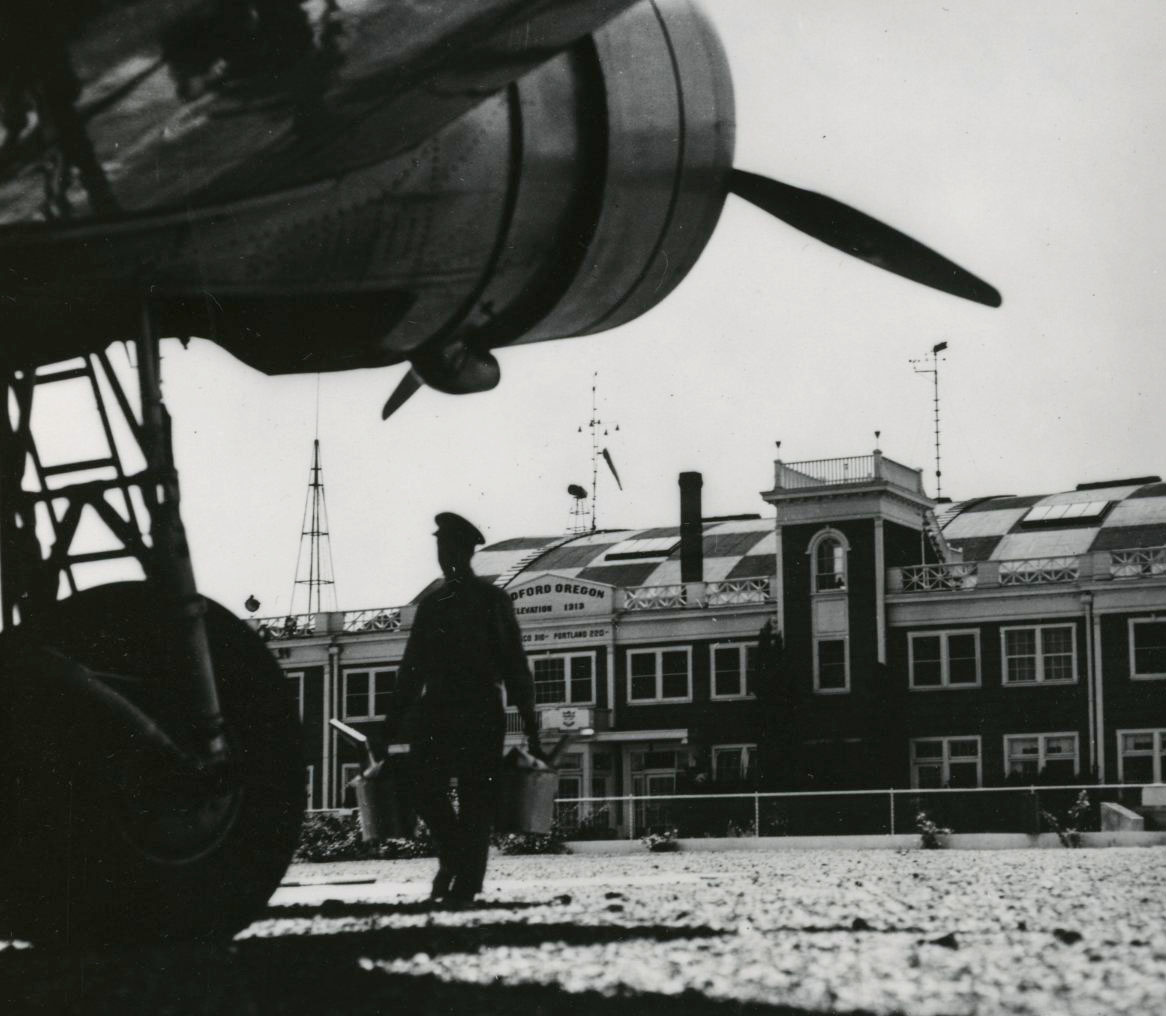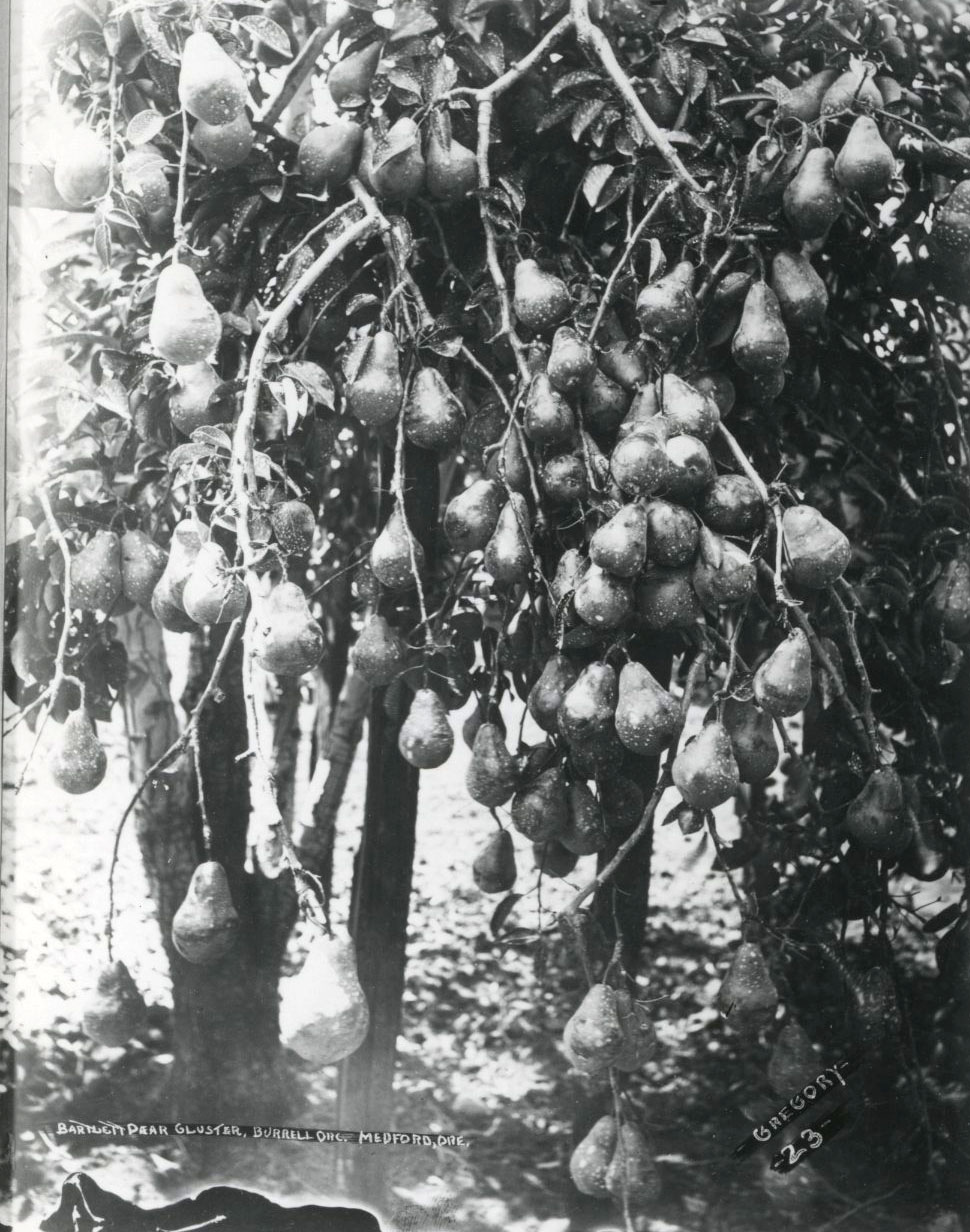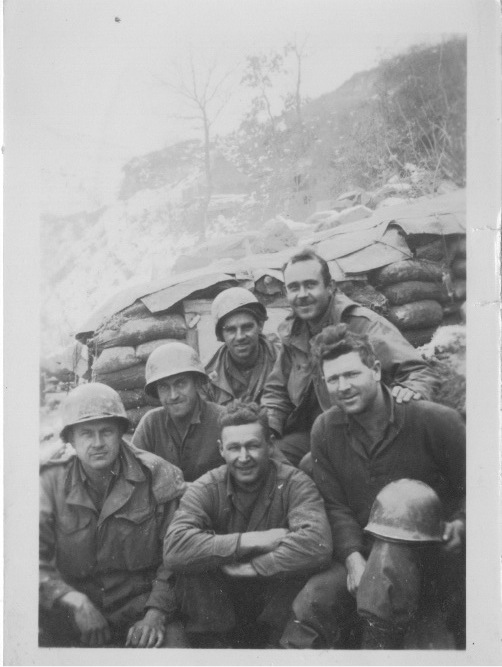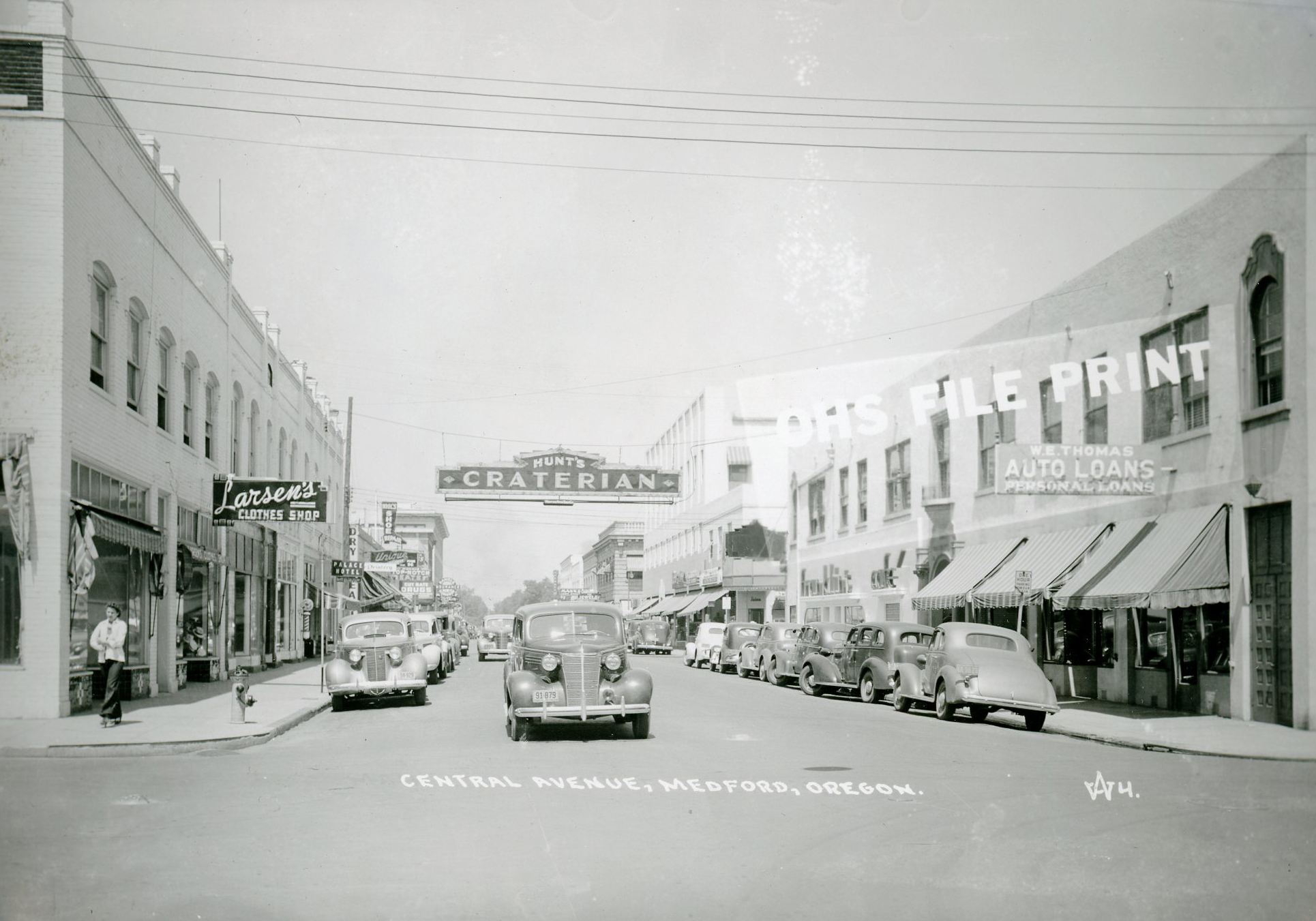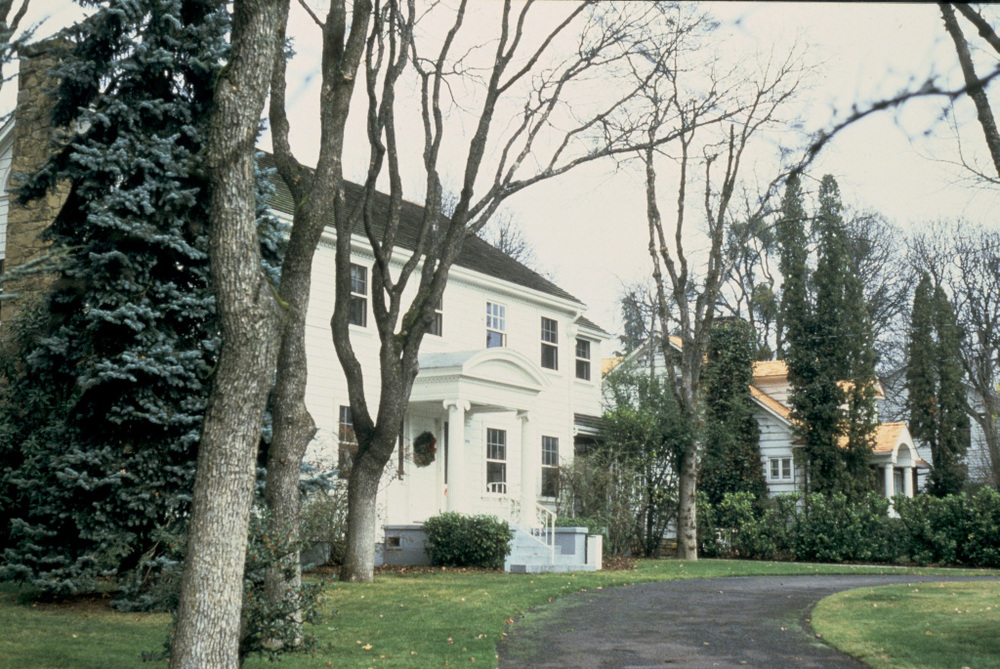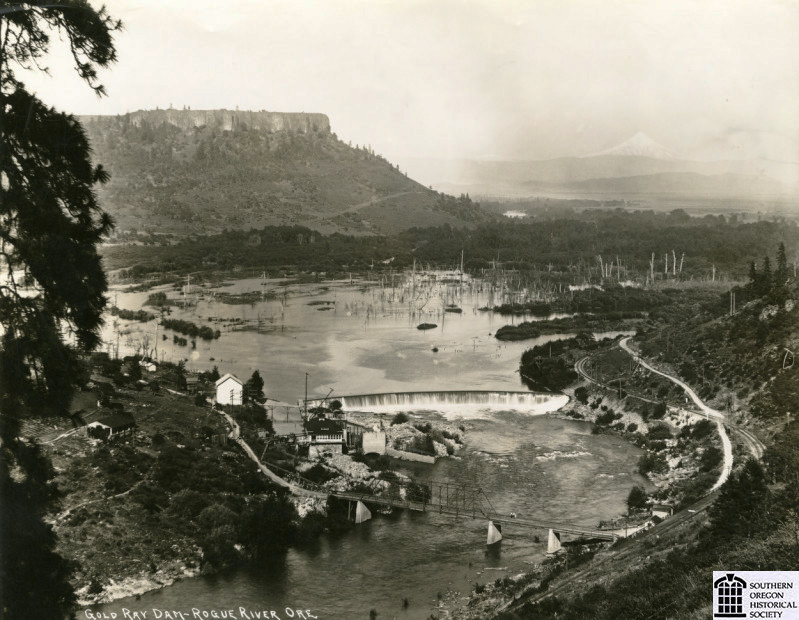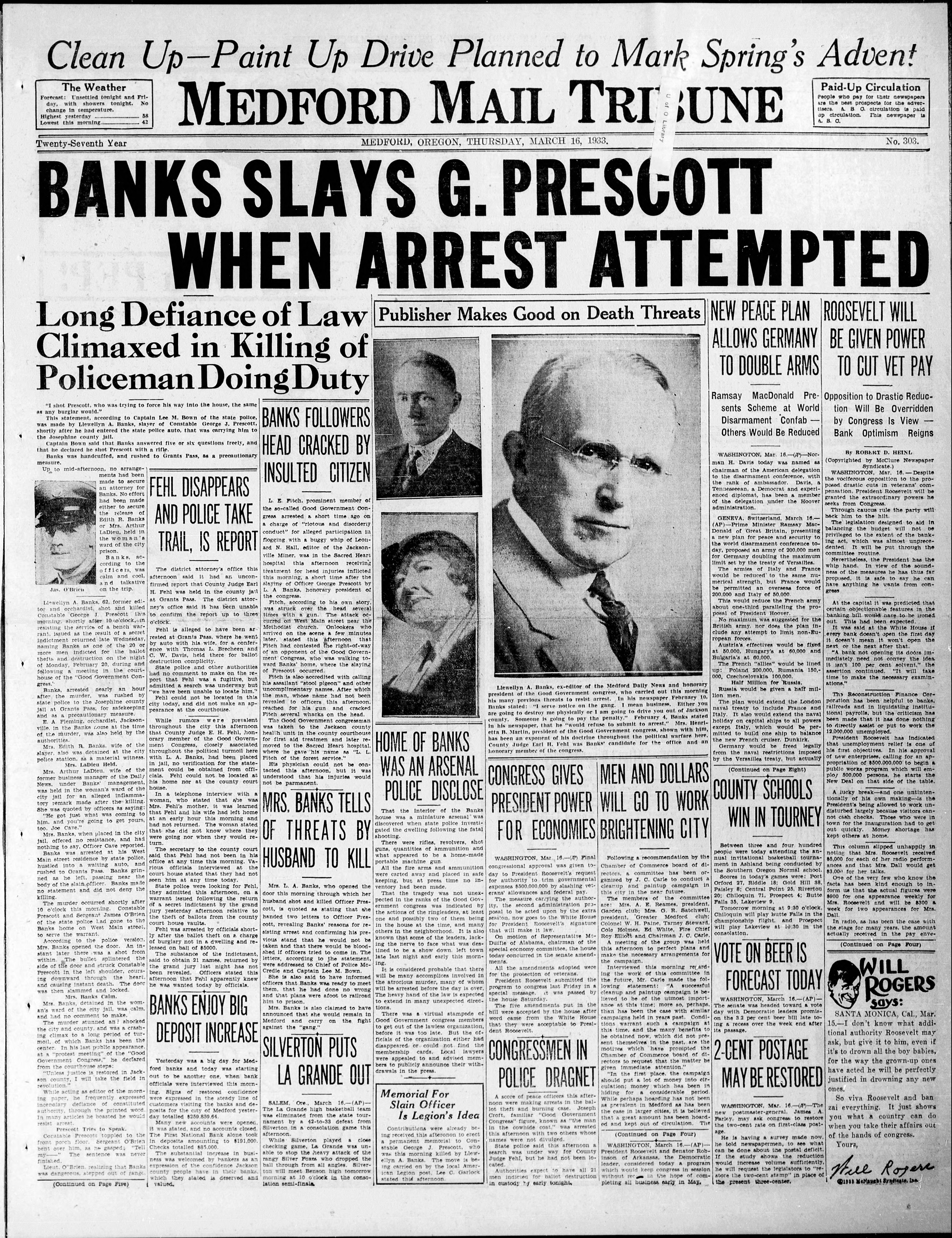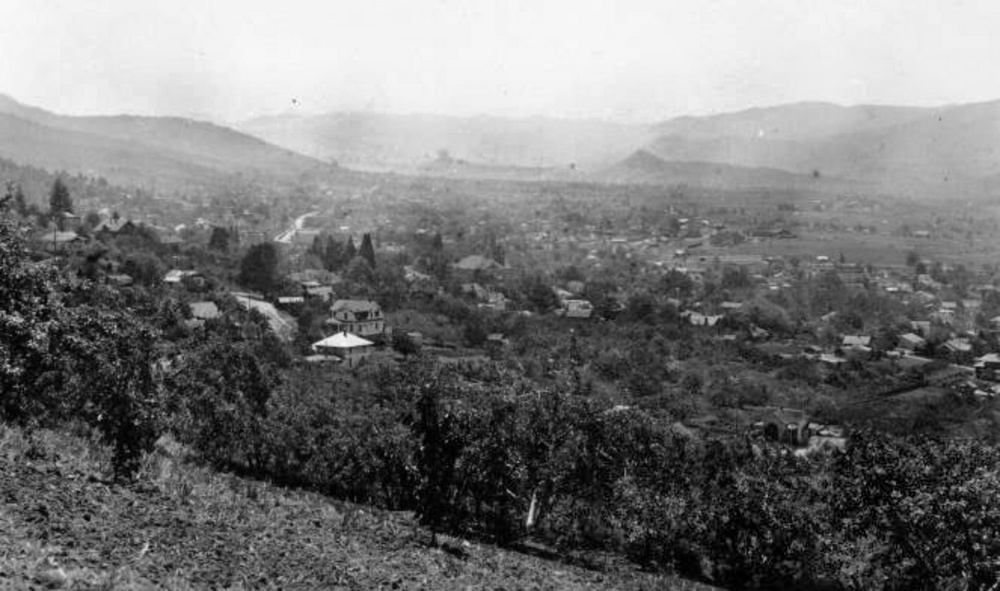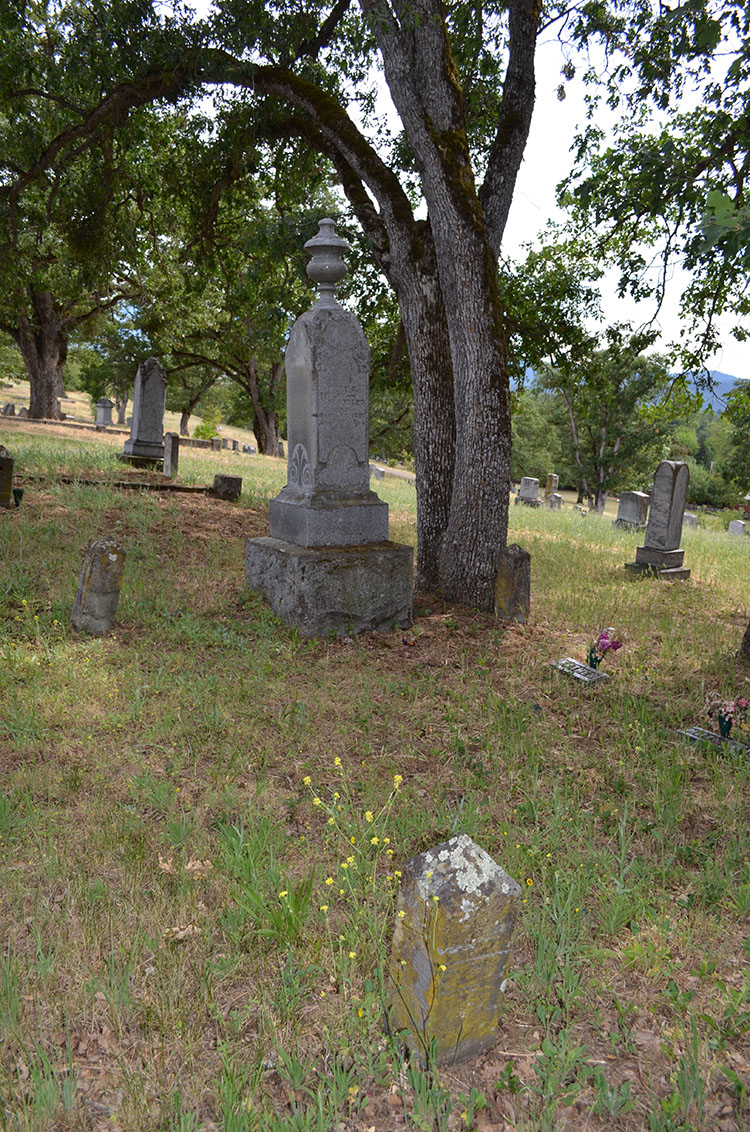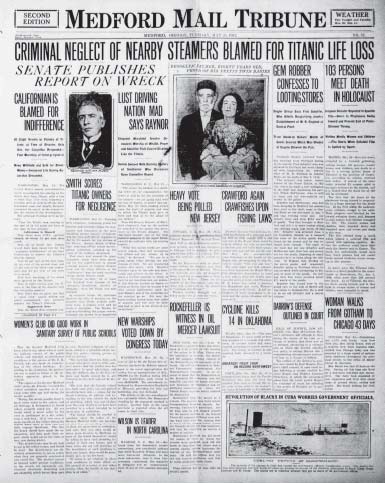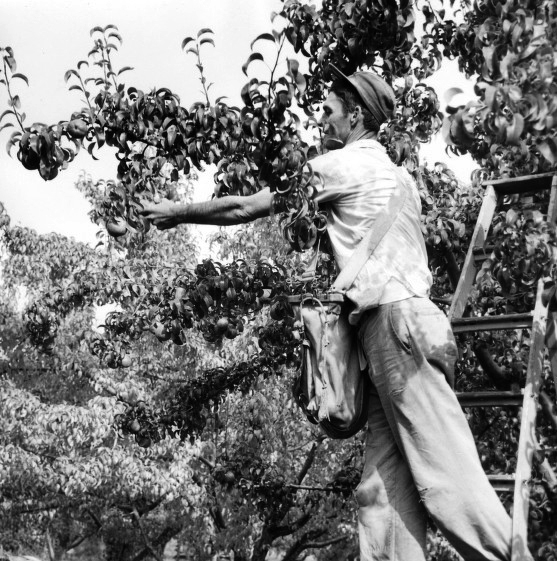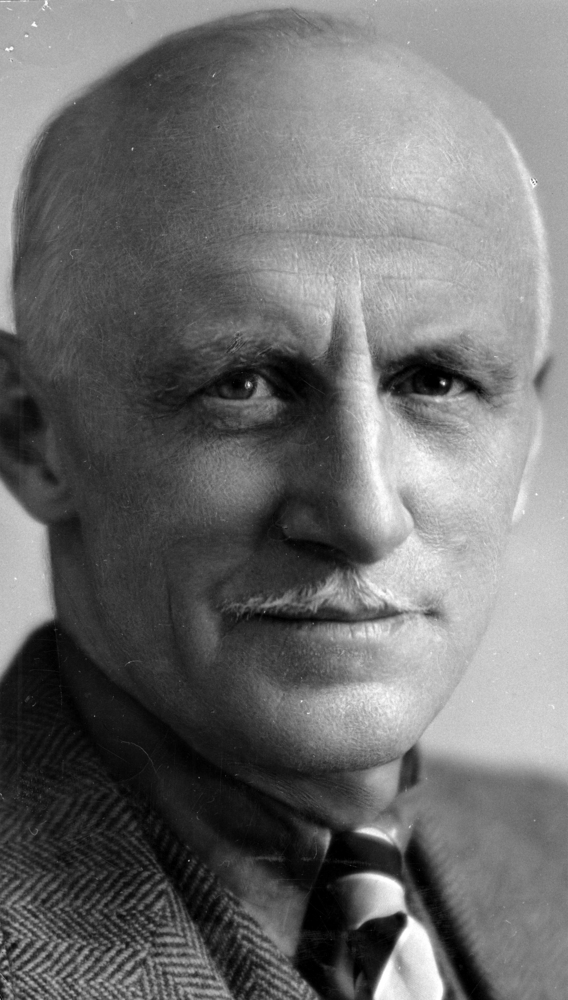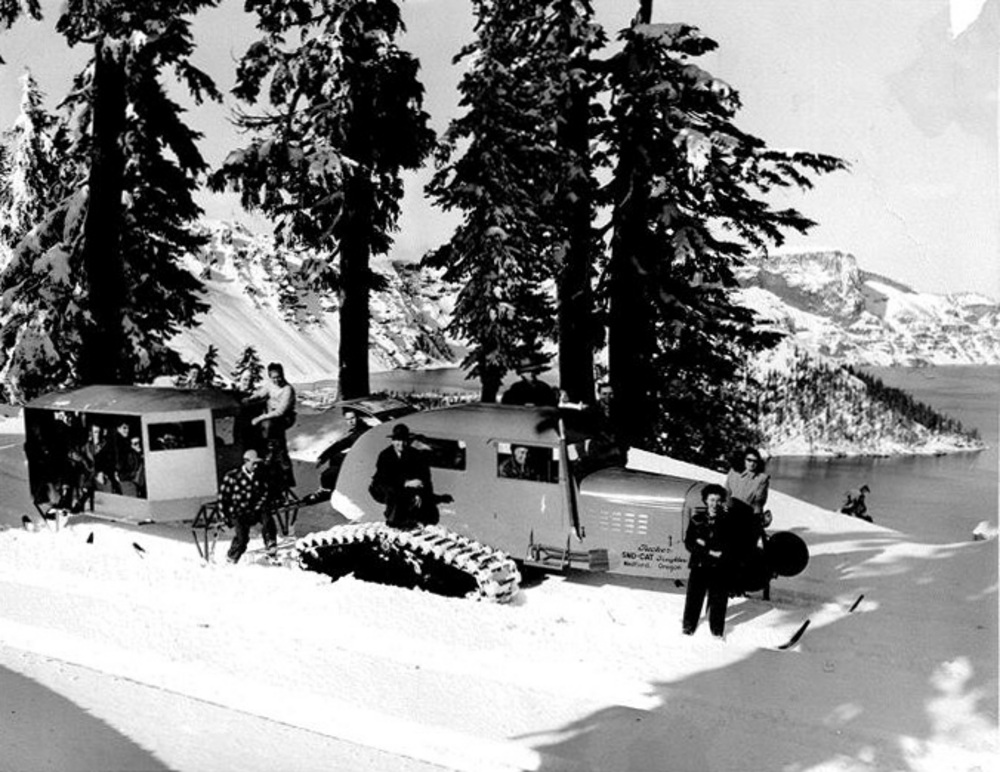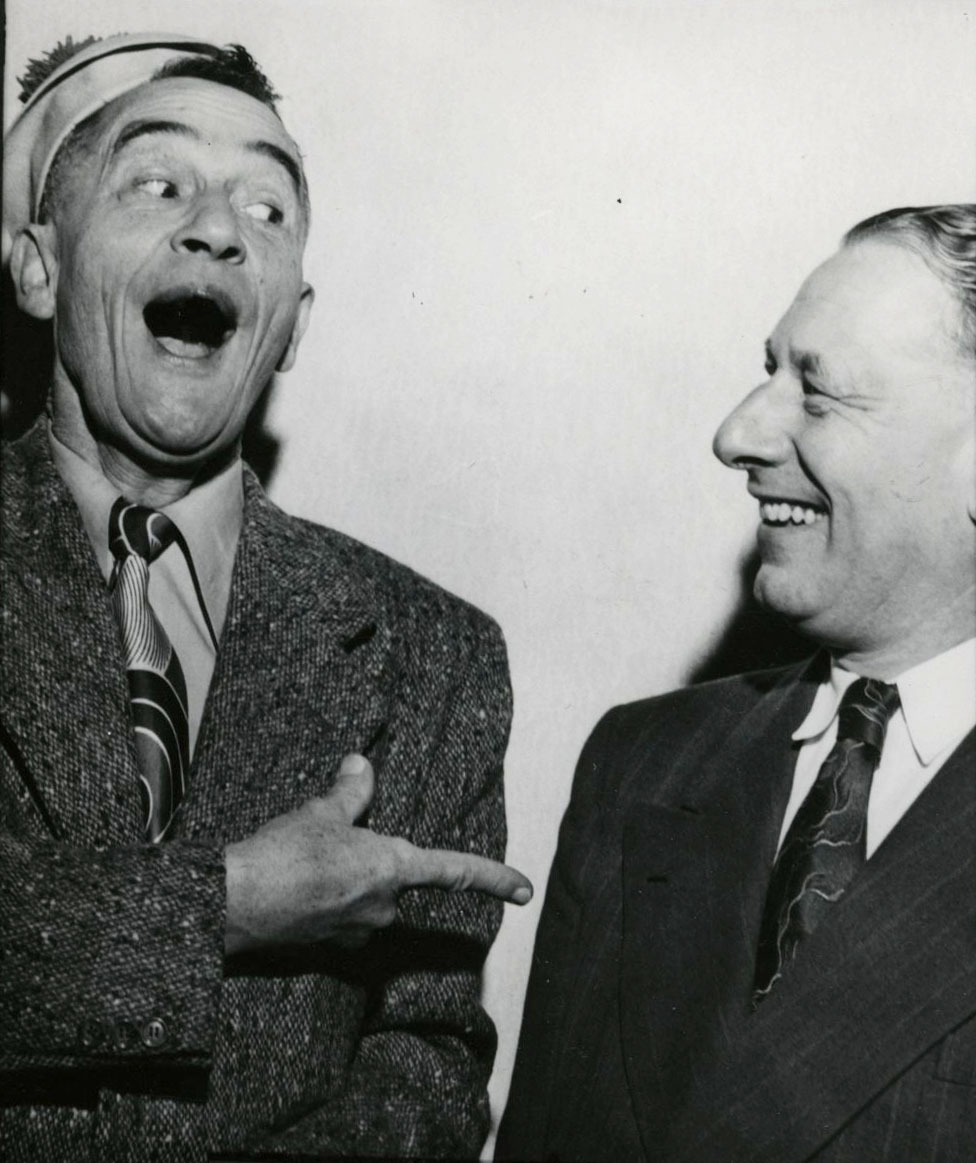Medford, the county seat of Jackson County, was platted in 1883 in the center of the Rogue Valley on Bear Creek. With more than 85,824 residents in 2020, Medford is the eighth largest city in Oregon and serves a metropolitan area of more than 200,000 people. The city is the primary retail, health, government, and service center for the Rogue Valley and some portions of northern California and is home to several prominent national businesses, including Harry & David, Lithia Motors, and Tucker Sno-Cat. Since the 1990s, the city’s slogan has been “Medford—The Center of it All.”
Originally the home of Shasta and Takelma peoples, the broad plain in the center of the Rogue Valley was a travel route between the richer upland areas that surround it. With EuroAmerican resettlement in the mid-nineteenth century, following the discovery of gold in the area, the central valley was transformed into large wheat fields and agricultural lands.
Medford was laid out in anticipation of the arrival of the Oregon & California Railroad (later the Southern Pacific) as it built track south from Roseburg, about a hundred miles to the north. David Loring, the right-of-way agent for the railroad, saw the benefits of a direct route through the center of the Rogue Valley, even though it would bypass the county seat in Jacksonville. In October 1883, C.W. Broback, I.J. Phipps, Conrad Mingus, and C.C. Beekman donated land along the west bank of Bear Creek to the railroad, which agreed to build its depot on the site. The new town was named Medford after a city near Loring’s home in Massachusetts. The first train arrived on January 18, 1884, and Medford was incorporated on February 24, 1885. By 1890, the town had 967 residents.
The railroad allowed southern Oregon products to reach larger markets, and Medford became a major shipping hub, primarily for pears, apples, and peaches grown in the valley. Southern Pacific, the Commercial Club, and local realtors promoted Medford’s climate, its business conditions, and the profits that could be made by growing and marketing fruit in the region. Between 1900 and 1910, years often called the Orchard Boom, Medford grew by 392 percent, to more than 8,840 residents, making it the third fastest growing city in the nation.
The new city attracted wealthy emigrants, many from Chicago, following in the footsteps of Mrs. Potter Palmer, a socialite from that city who developed the Modoc Orchards. Other Chicagoans made the move, included Harvard-educated H. Chandler Egan, the U.S. Amateur golf champion in 1904 and 1905, who moved to Medford and transformed his orchard into a golf course, the first in southern Oregon. Easterners Dr. C.R. Ray, supported by his wealthy brother Col. Frank H. Ray, invested in area gold mines and developed the Gold Ray Dam at Tolo, the first large-scale hydroelectric facility in the Rogue Valley. Many well-off college graduates, notably Alfred and Leonard Carpenter, arrived during the Orchard Boom and helped build the orchard industry in the Rogue Valley. The men established the University Club, and their wives formed the Colony Club, an organization for women.
In 1917, the Pacific Highway was completed through Medford, which had grown into the largest city in southern Oregon, and the surrounding forestlands had become the focus of large-scale timber developments. The Owens-Oregon Lumber Company was founded in 1924 with backing from midwestern lumber money. The company grew into the Medford Corporation (Medco), which along with KOGAP and other companies made Medford a major wood-products producer for the rest of the twentieth century.
In 1927, voters approved the transfer of the county seat from Jacksonville to Medford, and county government moved into the new Jackson County Courthouse in 1932. The courthouse was soon a focal point for a popular uprising, called the Jackson County Rebellion, the result of the so-called Good Government Congress, which culminated in the removal of elected officials under charges of sedition and murder. Publisher Robert Ruhl and the Medford Mail Tribune won a Pulitzer Prize for reporting on those events.
In 1942, a U.S. Army training facility, Camp White, was built northeast of Medford. Many of the men stationed there returned to the area after the war; Medford’s population grew by more than 50 percent between 1940 and 1950, to 17,305. The Rogue Valley Medical Center (now Asante) opened in 1958, and the Rogue Valley Manor was built in 1961, boosting Medford’s reputation as a regional health and retirement center. The Rogue Valley Mall, which opened in 1986, is the largest indoor shopping center between Eugene and Sacramento, and the Rogue Valley International Airport served more than 750,000 passengers in 2015.
Medford is the hometown of Vance DeBar “Pinto” Colvig, the voice of Disney’s cartoon dog Goofy (and others) and the inspiration and creator of Bozo the Clown. Dick Fosbury, Olympic medalist and the inventor of the Fosbury Flop, a style that revolutionized the high jump, attended Medford High School. Famed University of Oregon track coach Bill Bowerman got his start in Medford, and actor and dancer Ginger Rogers lived near Medford for much of her life. Medford-born John Frohnmayer, chair of the National Endowment for the Arts (1989-1992), is part of a prominent Medford family that included his father Otto and brother David, Oregon attorney general (1981-1991) and president of the University of Oregon (1994-2009).
-
![]()
Downtown Medford, c.1926.
Courtesy Oregon Hist. Soc. Research Lib., ba012368
-
![]()
Train depot, Medford.
Courtesy Oregon Hist. Soc. Research Lib., 62777
-
![]()
Medford, Oregon.
Courtesy Oregon Hist. Soc. Research Lib., 48912
-
![]()
Main Street, Medford.
Courtesy Oregon Hist. Soc. Research Lib., Orhi85858
-
![View of Roxy Ann Butte]()
Main Street, Medford, c.1920.
View of Roxy Ann Butte Courtesy Oregon Hist. Soc. Research Lib., ba012369
-
![Photo of Lucille Cummins]()
Main Street, Medford.
Photo of Lucille Cummins Courtesy Oregon Hist. Soc. Research Lib., ba12366
-
![Carnegie Library, Medford (1912)]()
Carnegie Library, Medford (1912).
Carnegie Library, Medford (1912) Courtesy UO Libraries, pna_02776
-
![]()
Aerial of Medford, Oregon, 1930.
Courtesy Oregon Hist. Soc. Research Lib., ba012414
-
![]()
Jackson County Courthouse, dedicated in 1932.
Courtesy Oregon Hist. Soc. Research Lib., 005909
-
![In spite of the roll sign displaying "East Main" Southern Oregon Traction Company car No. 1 is westbound on West Main Street in downtown Medford, c. 1915.]()
SOTCO No. 1 West Main Line Medford, c.1915.
In spite of the roll sign displaying "East Main" Southern Oregon Traction Company car No. 1 is westbound on West Main Street in downtown Medford, c. 1915. Courtesy Richard Thompson
-
![]()
Commercial Club, Medford.
Courtesy Oregon Hist. Soc. Research Lib., ba012407
-
![]()
Pacific Highway, Siskiyou Mountains, 1916.
Courtesy Oregon Hist. Soc. Research Lib., Orhi102420
-
![]()
Gold Ray Dam and Substation, Rogue River, 1924.
Courtesy Oregon Hist. Soc. Research Lib., Lot456-8
-
![]()
KOGAP Lumber Industries, Medford, c.1947.
Courtesy Oregon Hist. Soc. Research Lib., Orhi80345
-
![]()
Stewart Fruit Company employees.
Courtesy Oregon Hist. Soc. Research Lib., 009205
-
![]()
Rogue Valley Country Club and Golf Course, 1948.
Courtesy Oregon Hist. Soc. Research Lib., 0062777
-
![]()
Rogue River Valley pear orchards, 1942.
Courtesy Oregon Hist. Soc. Research Lib., 014035
-
![]()
Rogue Valley Memorial Hospital, Medford, 1958.
Courtesy Oregon Hist. Soc. Research Lib., 005907
-
![]()
Hotel Medford.
Courtesy Oregon Hist. Soc. Research Lib., 00120
-
![]()
Medford Airport, 1939.
Courtesy Oregon Hist. Soc. Research Lib., 005911
-
![]()
Pears on the Burrell Orchard, Medford.
Courtesy Oregon Hist. Soc. Research Lib., 018723
-
![Medford IOOF Cemetery]()
Medford IOOF Cemetery.
Medford IOOF Cemetery Courtesy George S. Stellingwerf
Related Entries
-
![Camp White]()
Camp White
Camp White, a U.S. Army Cantonment, was built on the Agate Desert, near…
-
![Craterian Ginger Rogers Theater at the Collier Center]()
Craterian Ginger Rogers Theater at the Collier Center
When fourteen-year-old Virginia Katherine McMath, better known as Ginge…
-
![Frank Chamberlin Clark (1872–1957)]()
Frank Chamberlin Clark (1872–1957)
Frank Clark practiced architecture for more than forty years in southwe…
-
![Gold Ray Dam]()
Gold Ray Dam
In 1900, Colonel Frank H. Ray persuaded his brother, Dr. C.R. Ray, to i…
-
![Good Government Congress (Jackson County Rebellion)]()
Good Government Congress (Jackson County Rebellion)
During the severe economic stress of the early 1930s, a homegrown, radi…
-
Harry & David/Bear Creek Orchards
Harry & David, the marketing brand for Medford's Bear Creek Corporation…
-
![John Edward Frohnmayer (1942-)]()
John Edward Frohnmayer (1942-)
John Edward Frohnmayer is a lawyer, writer, and arts leader who served …
-
![Lithia Motors]()
Lithia Motors
Lithia Motors in Ashland began in 1946 with a Chrysler-Plymouth-Dodge c…
-
![Medford IOOF Cemetery]()
Medford IOOF Cemetery
The Medford IOOF Cemetery, also known as the Eastwood Cemetery, was fou…
-
![Medford-Jacksonville streetcar system]()
Medford-Jacksonville streetcar system
Spencer S. Bullis organized the Southern Oregon Traction Company (SOTC)…
-
![Medford Mail Tribune]()
Medford Mail Tribune
For over a hundred years, the Medford Mail Tribune argued against what …
-
![Otto John Frohnmayer (1905–2000)]()
Otto John Frohnmayer (1905–2000)
Otto Frohnmayer was a prominent attorney, civic leader, and philanthrop…
-
Pears and the pear industry
European pears (Pyrus communis) thrive in the temperate climate of the …
-
![Richard Douglas “Dick” Fosbury (1947–2023)]()
Richard Douglas “Dick” Fosbury (1947–2023)
Dick Fosbury changed the high jump forever when he won a gold medal at …
-
![Robert Ruhl (1880-1967)]()
Robert Ruhl (1880-1967)
Robert Ruhl, publisher and editor of the Medford Mail Tribune, was Oreg…
-
![Tucker Sno-Cat®]()
Tucker Sno-Cat®
When Emmitt Tucker was a young boy in northwest Jackson County, he walk…
-
![Vance DeBar (Pinto) Colvig (1892-1967)]()
Vance DeBar (Pinto) Colvig (1892-1967)
Nicknamed Pinto because of his generously freckled face, Vance Debar Co…
Related Historical Records
Map This on the Oregon History WayFinder
The Oregon History Wayfinder is an interactive map that identifies significant places, people, and events in Oregon history.
Further Reading
Atwood, Kay. Medford, Oregon: Historic Context 1846-1946. Prepared for the Medford Planning Department, 1993.
Keating, Kevin. Medford: Images of America. Charleston, SC.: Arcadia Publishing, 2011.
Kramer, George. Medford Downtown Historic District, National Register of Historic Places Nomination, August 1997.

